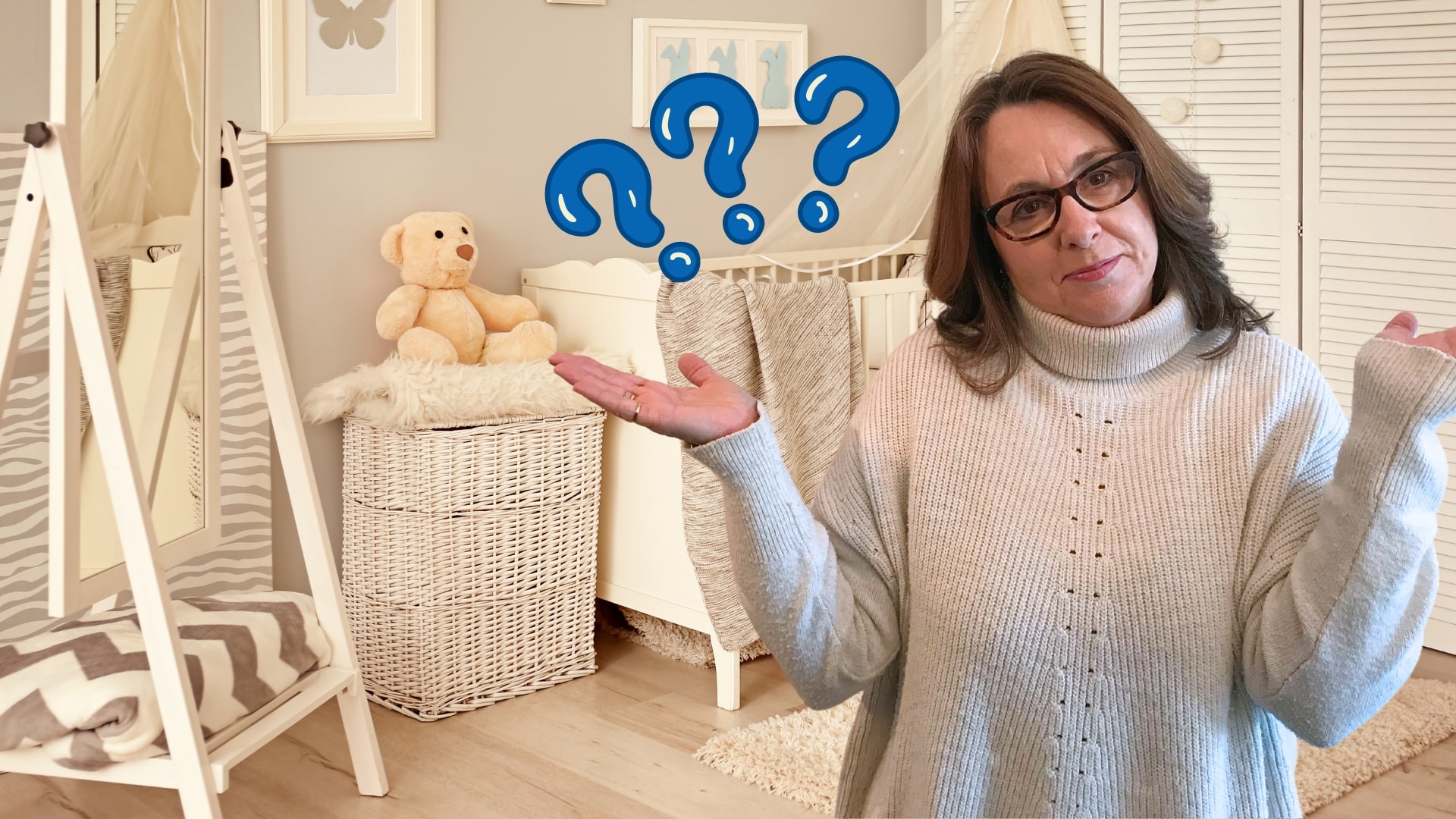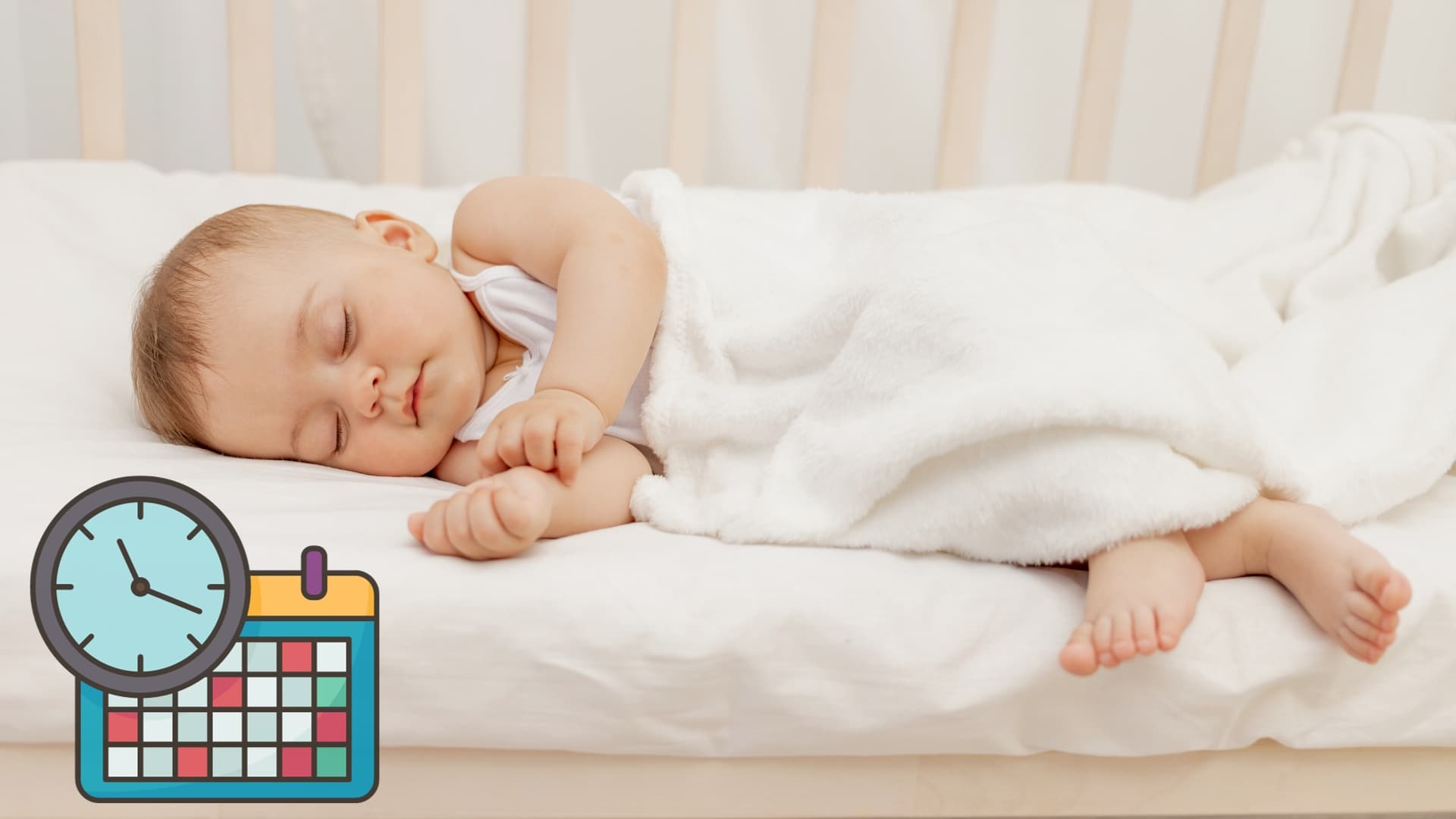Is your 9-month-old still waking multiple times a night, only sleeping when held, refusing to nap, and leaving you exhausted and desperate for a full night’s sleep? You’re not alone.
As well as establishing healthy sleep habits, sleep training 9-month-old babies is one of the best ways to help little ones (and you) get the sleep you all need.
In this guide, I will share with you over 40 years of childcare experience to help your baby learn to self-soothe and sleep for extended stretches. Keep reading to find out how to approach sleep training 9-month-old babies in a way that suits your family perfectly.
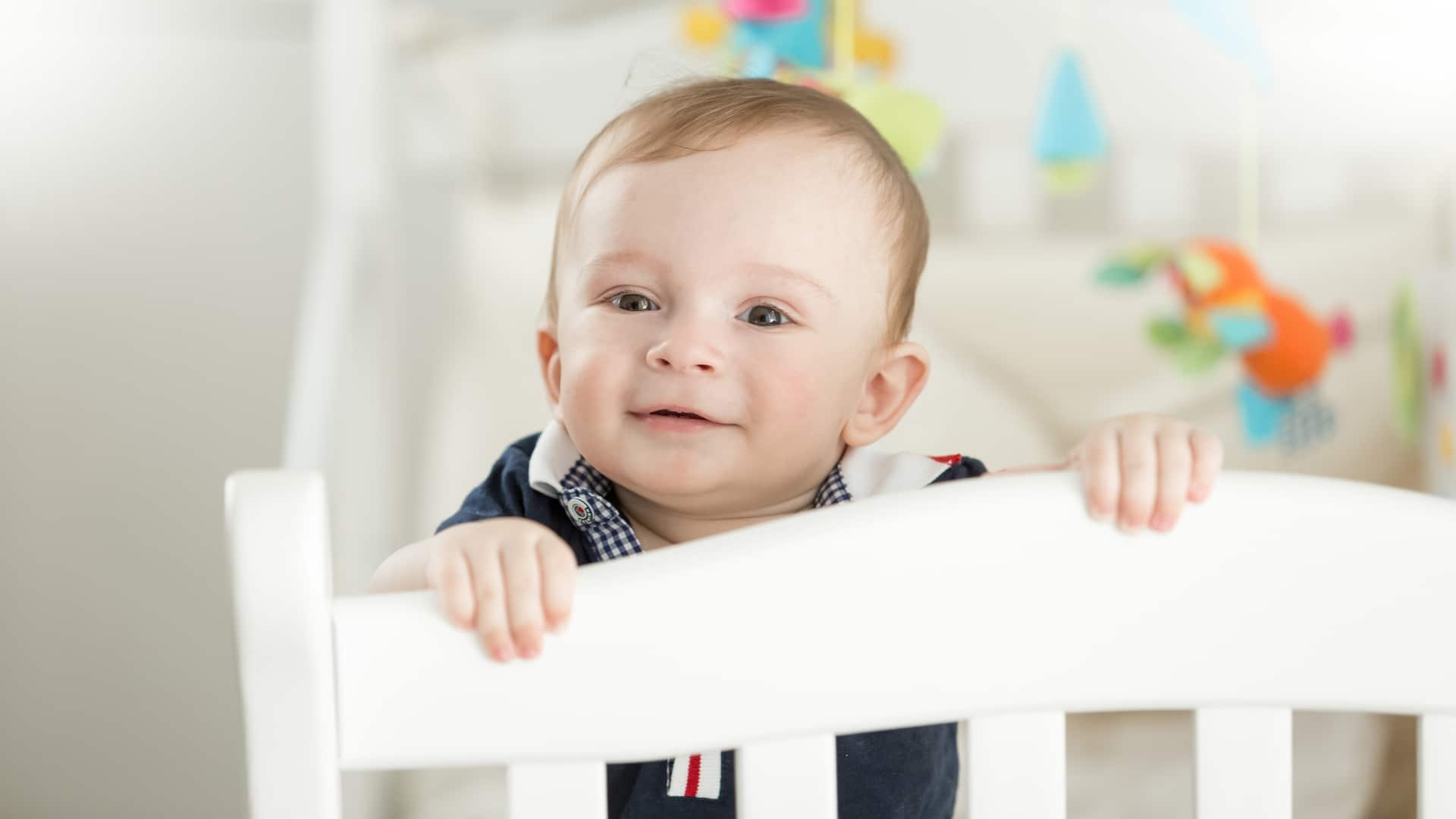
Table of Contents
Key Takeaways
- Sleep training is the art of teaching your baby to fall asleep independently and through the night by developing healthy sleep habits and breaking negative associations. It’s typically recommended for babies over the age of 6 months as they start to develop self-soothing abilities.
- Several gentle sleep training methods are suitable for 9-month-old babies like the self-soothe technique, chair method, and fading sleep technique. The goal is to help baby learn to fall asleep on their own without much crying. The cry-it-out method is more intense and may not suit all families.
- To help sleep training go smoothly, establish a consistent routine, have an age-appropriate sleep schedule, create a sleep-friendly environment, and watch for and act on your baby’s sleep cues promptly.
What Is Sleep Training?
Sleep training is when you teach your baby to fall asleep independently and sleep through the night. It involves developing healthy sleep habits and breaking negative sleep associations your baby may have developed over the early months. This is done by gradually teaching your baby to fall asleep on their own without the need for external soothing, such as contact napping, being rocked, or being fed to sleep.
Can You Safely Sleep Train A 9-Month-Old?
The American Academy of Pediatrics (AAP) suggests that you can start sleep training when your baby is around 4 to 6 months old.
So, yes, you can safely sleep train a 9-month-old baby.
At this age, your baby will have started to develop more regular sleep patterns and be developmentally able to sleep through the night.
By now you are quite naturally ready for some more consistent night’s sleep too and you should never feel guilty about prioritizing your rest.
As I always say, investing in your child’s sleep to allow you to get more sleep makes you a better parent tomorrow.
Looking to get your little one to sleep quickly and effortlessly? Check out my Bedtime and Nap Cheat Sheet and master the art of making daytime naps and bedtimes as seamless as possible.
A bedtime & nap cheat sheet so good your little one will ask you to put them to bed...
Laura Williams "This is a life saver! I'm so glad I downloaded your bedtime & nap cheat sheet. My little one actually asked me to put him to bed last night! Unbelievable! Thank you so much!"
Click Here For The FREE Cheat Sheet
Preparing for Sleep Training
At 9 months of age, babies are learning lots of new skills rapidly, such as crawling and cruising, which can impact their sleep patterns and trigger sleep regressions resulting in them fighting sleep and waking more often at night.
However, there are several things you should have in place before you start sleep training.
These tactics are the foundation of my nannying career and I firmly believe that by implementing them, you will make sleep training run more smoothly and in some cases… avoid you having to sleep train at all.
This is because there is so much more to sleep training than just picking a method and implementing it.
So before you dive into sleep training your 9-month-old, put this essential list in place so that you can begin to guide your little one towards independent sleep and self-soothing naturally:
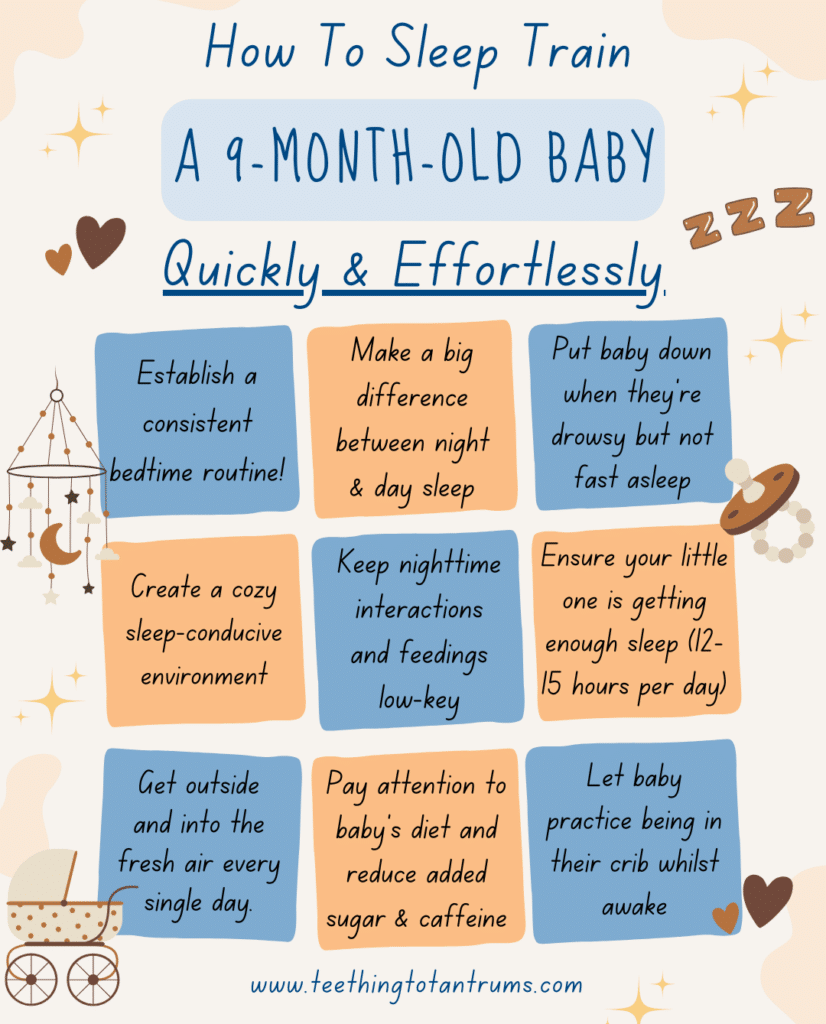
- Start to establish a recognizable and regular bedtime routine that includes a warm bath, and baby massage, followed by calming activities like reading baby books or singing lullabies.
- Make a marked difference between daytime and nighttime sleep. Daytime naps can be accompanied by housework in the background, TV noises, and vacuuming, for example. Nighttime sleep should be dark, quiet, and cozy.
- Put baby down to sleep while drowsy but not fast asleep. I know this is easier said than done… but try to encourage your little one to fall into a deep sleep independently. Try warming their blankets so your 9-month-old is not getting into a cold crib and if they squirm slightly, gently rest your hand on their tummy to reassure them you’re still there.
- Create a sleep-conducive environment in your baby’s room that is dimly lit and at the correct temperature. Use a white noise machine to prevent ambient noise from disturbing your little one.
- Keep nighttime interactions and feedings low-key with little to no talking and no bright lights. Consider using a nightlight to help keep the sleep environment consistent (meaning you don’t have to turn on any lights when handling nighttime wakings).
- Ensure your little one is getting enough age-appropriate daytime sleep to avoid overtiredness which can disrupt the entire sleep schedule. Keep an eye on your baby’s wake windows to ensure they’re not awake for too long to prevent overstimulation. For a 9-month-old, this is typically around 3-4 hours. Read my post on the 9-month sleep schedule to learn what to expect.
- Get outside in the fresh air and natural light every day to balance your baby’s circadian rhythm and melatonin levels and promote healthy sleep.
- Pay attention to baby’s diet. Avoid sugary or caffeinated food and drinks in the evening and make sure they have plenty to eat during the day so that hunger is not the cause of nighttime waking. 9 month olds need between 750 and 900 calories a day, of which about 400 to 500 calories should come from breast milk or formula.
- Let baby practice being awake and alone in the crib without the pressure of going to sleep. Putting your little one in the crib to look at an interesting mobile, like this one from Manhattan Toys while you take a quick shower is a good way of getting them used to being awake alone in their sleep space. This can help with teaching them to self-soothe and not always cry out on waking.
Suitable Sleep Training Methods For A 9-Month-Old
OK, so if you’ve implemented all of my above tips and you’re still struggling to get your 9-month-old to sleep independently…
It’s time to implement a sleep training method.
When considering sleep training methods for your 9-month-old, it’s important to choose an approach that feels right for your family and not what the latest trend is.
It’s also important that all your baby’s caregivers are on the same page with the chosen method as this ensures consistency, which is essential for your little one to learn new sleep habits.
Here’s a look at some suitable methods for your 9-month-old baby:
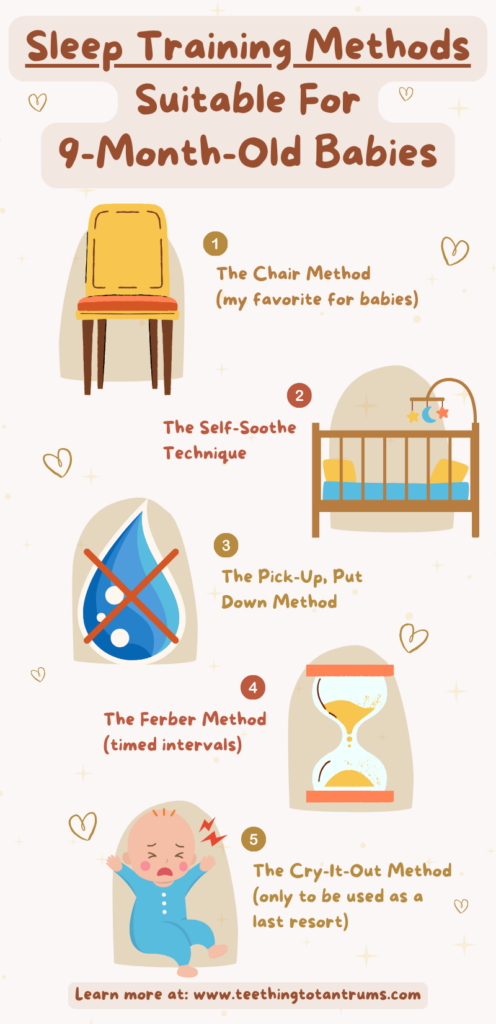
1. The Chair Method (My Favorite)
The Chair Method is my go-to sleep training method for 9-month-old babies and one that I have found to be very effective.
To implement this gradual and comforting method, stay in the room with your little one after you have said goodnight, and sit next to their bed until they fall asleep.
Night after night, move the chair further away from the crib.
If your baby whines, wait a little while to see if they’ll resettle by themselves. If they don’t, offer a pat or rub on the tummy to soothe your baby back to sleep, then return to your chair.
2. The Self-Soothe Technique
The self-soothe sleep method is a more subtle sleep training style and the one I would always recommend parents try if the Chair Method has not worked.
It involves helping your baby to fall asleep on their own without any assistance from you by putting into place a routine that gives them the best possible chance to fall asleep independently.
This means weaning off contact napping, having a consistent nap and bedtime routine, putting your baby down when they are drowsy and not fast asleep, and gradually reducing the amount of time you spend with your baby settling them.
(Essentially all the sleep habit tips I outlined at the beginning of this post)
You can also consider using a pacifier at night if it helps baby settle.
3. The Pick-Up, Put-Down Method
Also known as the “No Tears” approach, the Pick-Up, Put-Down method also involves putting your baby down when drowsy but not fast asleep… but unlike the Chair Method, you leave them for a short while, and if your baby fusses, you pick your baby up until they are calm then put them down again.
You repeat this method until your baby manages to fall asleep without being held.
As this is a gentle sleep training method, it will be less stressful for you and your baby, but it can take longer to achieve results. Therefore, the Pick-Up, Put-Down Method can be very tiring for parents.
But many have had great success with it so give it a try if your baby needs a lot of physical reassurance to settle.
TOP TIP: Don’t rush in every time your baby wakes. A little fussing is normal and you may find your baby re-settles themself after a few minutes.
4. The Ferber Method
The Ferber Method is a very well-known sleep training technique. It is commonly interchanged with Graduated Extinction, however, the difference is that The Ferber Method involves using set time intervals to leave your baby to cry before offering comfort (2 minutes, 5 minutes, 10 minutes).
It’s a structured approach that many parents find effective. However, at 9 months of age, I would recommend trying the Chair Method or the Self-Soothe technique first as these are gentler sleep training techniques.
To learn more about the Ferber Method read my post: Ferber Method: A Proven Sleep Training Technique For Infants
5. The Cry-It-Out
Also known as the extinction method, the Cry-It-Out (CIO) Method is a stricter sleep training approach where you say goodnight and leave your baby to fall asleep without returning.
It can be challenging but yields quick results for some families.
I am not a fan of the cry-it-out method and believe it should only be used as a last resort if you’ve tried all of my tips and other techniques without success.
But I would not be doing my job if I didn’t provide you with all the options for sleep training 9-month-old babies.
To learn more about the Cry-It-Out Method read this post: The Truth About The Cry-It-Out Method From A Norland Nanny
NOTE: If you are considering using the Cry-It-Out Method, be sure to check with a pediatrician to determine if it’s appropriate for your child BEFORE implementing its strategies.
How Long Does It Take To Sleep Train A 9-Month-Old?
As all babies are different… it is important to bear in mind that it might take a little while for your 9-month-old to adjust to your chosen sleep training method depending on their temperament and your resolve.
The truth is… there is no set time for how long sleep training at 9 months old can take and you may experience periods of success followed by periods of your little one waking more at night or struggling to settle.
But in my experience, sleep training a 9-month-old can take anywhere from 3 days to 3 weeks for the change to stick.
TOP TIP: Avoiding overtiredness is a crucial factor in determining the success of sleep training. An overtired baby has a harder time falling asleep and staying asleep. So ensuring your baby is getting enough daytime sleep can make the difference between success and failure.
Nap Sleep Training A 9 Month Old
When you’re sleep training your 9-month-old, naps will play a crucial role in the success of your baby’s nighttime sleep as they will reinforce the healthy sleep habit you are trying to establish.
At 9 months of age, most babies are ready for two naps per day, typically in the mid-morning and early afternoon after the midday meal lasting about 1-2 hours.
To ensure nap time success, follow these tips:
- Start winding down about 30 minutes before nap time.
- Have a pre-nap routine that indicates to your baby that sleep is approaching. This can be reading a short book, having a cuddle, holding a special blanket, or playing soft music to help baby associate sleep with cozy activities.
- Create a sleep-conducive environment by ensuring the nap area is quiet, dimly lit, and comfortable. Use white noise or an audio app to block out disruptions.
- If your baby resists napping, stay patient and do not return to old habits. It takes time for new habits to form and if you start rocking your baby to sleep again, you’ll be undoing all your hard work!
To learn more about what your 9-month-old’s sleep and nap schedule should look like, read this post: The Perfect 9-Month-Old Sleep Schedule
And consider reading my article on sleep training for naps for more specific advice about helping babies learn to sleep independently during the day: Sleep Training For Naps.
REMEMBER: Your 9-month-old’s afternoon nap should finish about 3-3.5 hours before their scheduled bedtime. Don’t be afraid to wake your little one from their afternoon nap to accommodate this or push bedtime out a little to make sure your baby is ready for sleep at bedtime.
Baby Sleep Training Books I Recommend
When implementing sleep training for your 9-month-old baby, it is really helpful to be well-informed about the subject.
Reading this article will certainly have helped!
But reading some books about specific sleep training methods will be even more helpful.
However, you must remember that your little one is a unique individual and you need to adapt to your baby’s individual needs.
Follow the advice that feels right for you and your baby and do not embark upon a sleep training method just because it is ‘supposed’ to work quickly.
I have read many books on the subject as well as acquired a lot of experience over the years about what sleep training method works for which age group.
So without further ado, here are a few of my favorite books that I suggest reading when sleep training a 9-month-old baby.
1. Healthy Sleep Habits, Happy Child by Dr. Marc Weissbluth
A fantastic sleep training resource for parents of young babies is “Healthy Sleep Habits, Happy Child” by Dr. Marc Weissbluth. It’s full of research-based tips and a step-by-step plan to help you understand the importance of sleep and how to foster it in your baby’s life.
In this brilliant book, backed by decades of research and case studies, Dr. Weissbluth presents the Ferber method, a gentle form of sleep training that involves teaching babies to fall asleep independently with check-ins.
Charts and routines cover naps, nighttime sleep, and adjusting schedules. The book also addresses common issues like bedsharing, co-sleeping, night wakings, and daytime sleepiness giving you an all-inclusive sleep training approach!
- Provides individualized plans based on baby's exact age
- Evidence-based and developmentally appropriate
- Addresses a wide variety of common sleep questions
- Offers flexibility within routines based on baby's temperament and needs
- Teaches independent sleep skills
- Requires consistency to see full effects
- Focuses heavily on rigid routines and schedules
- May be overwhelming amount of information for some
- The adaption of the Ferber Method can be difficult for some babies to handle
2. The No-Cry Sleep Solution by Elizabeth Pantley
The No Cry Sleep Solution provides strategies that steer clear of letting your baby cry it out. Instead, it offers gentler alternatives to help your baby sleep through the night. It’s particularly favored by parents of 0-5 year olds seeking a softer sleep training method.
Gently guiding your toddler to better sleep becomes less of a battle with this book. The No-Cry Sleep Solution aims to provide you with researched, kind methods that respect your child's needs.
Implementing the tips provided feels relevant and doable, as each chapter follows through with advice matched to common situations.
What's truly beneficial is the understanding of sleep you gain. It's a relief to have your experiences validated and then addressed, flipping the script on bedtime struggles.
You're not just reading; you're learning and applying new strategies each night.
- Endorsed by many parents over the last 18 years for its effectiveness
- Focused on gentle techniques
- Includes valuable research insights
- Offers specific advice for 1-5 year olds
- Follows a gentle child-centred approach
- Covers a variety of bedtime issues such as night wakings and getting your toddler to stay in bed
- May not work for every child
- Some information might overlap with books you've previously read
- The solutions require patience and time
3. The Gentle Sleep Book by Sarah Ockwell
The Gentle Sleep Book by Sarah Ockwell provides a holistic insight into childhood sleep and explains that very often our expectations are way too high when we expect our little ones to sleep through the night and that we aim for this perfection when they are not developmentally programmed to do so.
In a lot of ways, this is a book that makes parents who are battling with sleep issues feel ‘OK’ with what they are doing whether that be co-sleeping or nursing to sleep.
Sarah Ockwell Smith provides a holistic insight into childhood sleep in this book. She explains that very often our expectations are way too high when we expect our little ones to sleep through the night and that we aim for this perfection when they are not developmentally programmed to do so.
In a lot of ways, this is a book that makes parents who are battling with sleep issues feel ‘OK’ with what they are doing whether that be co-sleeping or nursing to sleep.
If you are happy to take this more relaxed approach to sleep training then this is probably the book for you.
- Offers a gentle approach to sleep training
- Offers reliable evidence-based advice
- Deals with night wakings as well as bedtime issues
- Offers advice for each developmental stage
- Covers how to deal with daytime nap issues too
- Mentions that bed sharing is OK... which is not for everyone
- The solutions take time... however, there's never a quick fix
- May be considered more of a parent self-help book than a sleep training book
TOP TIP: If you have not yet started night weaning, now would certainly be a good time as 9-month-olds can sleep through the night without feedings. Continue to implement a dream feed if it helps and if your baby is taking a bottle to fall asleep, read this post to learn how to wean them off it.
Will Sleep Training Harm A 9-Month-Old?
Contrary to some concerns, sleep training done properly does not harm children. Research shows it can actually benefit both parents and babies.
A study by the American Academy of Pediatrics divided infants into two groups – one went through sleep training, and the other did not. They measured the babies’ cortisol stress levels, parental satisfaction, parental stress, and the children’s attachment styles at one year old.
Results found that babies who were sleep-trained had decreased cortisol by the end of the training, indicating lower stress.
And at one year old, there was no difference in attachment style or behavior between the groups.
So with the right methods and environment, sleep training helps babies learn to self-soothe without negatively impacting development.
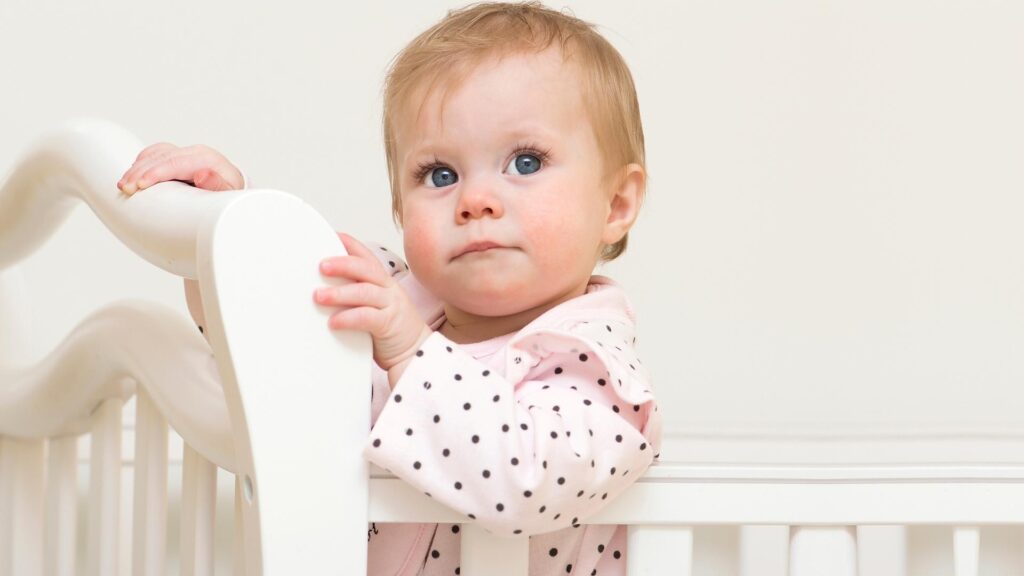
Addressing Common Sleep Training Challenges
Sleep training a 9-month-old can involve addressing some additional challenges that arise from where your baby is at in their development.
Common issues that you may have to address are:
- Teething Discomfort: Your baby may experience discomfort from teething that disrupts sleep. If your little one is suffering from teething pain offer a teething toy or a cold washcloth to chew on before bed to alleviate gum pain.
- Navigating Sleep Regressions: Sleep regressions often occur around 9 months. If you suspect this to be the cause of your little one’s disrupted sleep, try to maintain a calm and consistent bedtime routine to help your baby cope. During regressions, extra comfort is key, but continue to try and encourage self-soothing so that your baby learns to settle back to sleep independently. To learn more about how to handle the 9-month sleep regression, read this post: The 9-Month Sleep Regression Survival Guide.
- Check For Stressors: If there has been a major change in routine, your baby’s sleep can easily be disrupted. Whatever is going on try to maintain a peaceful and cozy sleep environment and routine to instill security. White noise machines and audio apps are great ways to offer comfort during this phase. Consider using a night light too.
- Daytime Sleep: This is very important as adequate age-appropriate naps will reduce the chances of overtiredness. An overtired baby will most definitely struggle to fall asleep and stay asleep so getting daytime sleep right can be a game changer and improve nighttime sleep significantly. Aim for two naps a day, each 1-2 hours long.
- Nap Transition: If your little one has not yet transitioned from 3 to 2 naps… they will do so very soon. Be flexible during this time and try to avoid your little one becoming overtired. Take a look at our post on how to handle nap transitions: Mastering The 3 To 2 Nap Transtition Effortlessly
Can You Sleep Train During The 9-Month Sleep Regression?
At 9 months old, your baby may experience a sleep regression which is characterized by more frequent wakenings, resistance to nap, and increased fussiness and clinginess.
However, the good news is that YES, you can still sleep train during the 9-month sleep regression.
However this doesn’t mean you need to put sleep training on hold, but it’s essential to adjust your approach and to be kind.
- Stick to a calming regular bedtime routine to signal that it’s time to rest. Include a warm bath, baby massage, and baby books to get them primed for sleep.
- Utilize a dream feed to prevent hunger from waking your baby up at night.
- Continue to put baby down when they’re drowsy but not fast asleep and always act on sleep cues to avoid overtiredness.
- Try to avoid overtiredness by making up for bad nighttime sleep with an extra daytime nap. Remember to keep an eye on the amount of sleep your baby is getting in 24 hours. A 9-month-old baby needs 12-15 hours of sleep per day.
- Get outside every day in the natural light and fresh air to balance their circadian rhythm
- Make sure your 9-month-old has lots of opportunities to practice any new skill they may be mastering.
REMEMBER: Consistency is always KEY when it comes to sleep, especially when your baby is going through sleep disruptions.
When To Seek Medical Advice
At any point in your little one’s development if you have concerns you should seek medical advice to put your mind at rest.
And it’s even more important to seek medical advice if you suspect your baby’s sleep patterns are out of whack.
They are best qualified to assess if your baby’s sleep patterns are a sign of underlying issues and whether sleep training is appropriate.
Things to watch out for include:
- Your baby constantly struggles to fall asleep or wakes up crying during the night which does not improve with sleep training.
- Your little one is consistently overtired during the day or showing signs of heightened separation anxiety.
- There are significant changes in eating habits alongside sleep concerns.
- You observe behaviors or symptoms that are not typical for your baby.
Remember that occasional wakefulness is normal, but persistent sleep difficulties are definitely worth a professional’s attention.
Milestones, growth, and development are always intertwined with sleep. If your child is not making expected progress, a medical professional should evaluate them.
Your pediatrician can also offer guidance tailored specifically to your baby’s needs and most importantly they can verify whether your baby is on track with growth and development milestones.
Remember, seeking advice is a proactive step in ensuring your child’s well-being. If you have any doubts about your infant’s health or sleep habits, don’t hesitate to reach out to a healthcare provider.
NOTE: Keeping track of your baby’s nap and nighttime sleep in a diary is an incredibly valuable asset if you need to talk to a pediatric sleep consultant about your little one’s sleeping habits.
With one spacious page dedicated to each day, you'll have plenty of room in this delightful planner to write down all your to-dos, appointments, and notes for the year.
Ideal for parents tracking baby's sleep, feeding, and pooping schedules...
Or a sleep journal for toddlers...
Whatever your requirements for the diary need to be, this handy planner will tick the right boxes.
Frequently Asked Questions About Sleep Training 9-Month-Old Babies
Looking for more information about sleep training a 9-month-old? Have a specific question you’d like to ask?
Here are the most common questions asked about sleep training a 9-month-old baby you need to know the answers to.
Q: What methods are effective for sleep training a breastfed 9-month-old?
A: Firstly, I would suggest gradually reducing the amount of time you spend nursing before sleep as this can encourage your baby to associate sleep with being put in their crib, rather than being fed. You could also offer breast milk in a bottle to wean them off always being held by you before bedtime. After that, I would suggest the Chair Method or the Pick-Up, Put-Down Method.
Q: What strategies can I use to help my 9-month-old sleep through the night?
A: Establish a calming bedtime routine to signal that it’s time to sleep. This could include a warm bath, gentle rocking, and a quiet lullaby. Ensure your 9-month-old’s sleeping environment is conducive to sleep, with minimal light and comfortable temperatures. Use a white noise machine or sleep app to help settle your baby and create a peaceful sleep space.
Q: How can I establish a successful nap routine with my 9-month-old through sleep training?
A: To establish a successful nap routine, create a mini version of your bedtime routine to make nap time predictable, such as reading a short book or playing a lullaby. Ensure the nap environment is quiet, dark, and comfortable to promote uninterrupted sleep again using a white noise machine or sleep app to block out background noise. Using black out blinds can also help with daytime sleep.
Q: Can a sleep regression affect sleep training outcomes for a 9-month-old, and how can it be managed?
A: Yes, a sleep regression can temporarily disrupt sleep patterns at 9-month-old… But to manage this phase quickly and effectively, be patient and maintain your chosen sleep training method as much as possible. Keep a consistent bedtime and naptime to help mitigate the effects of sleep regression. And offer reassurance and comfort if your baby is more clingy or wakeful than usual.
Q: At 9 months, is it still possible to start sleep training, and can it be successful?
A: Absolutely! It’s never too late to start sleep training at 9 months. In fact, many families have better sleep training success starting at this stage because older infants better adapt to routines and do not require feeding at night.
Need More Parenting Help?
- Download our FREE Bedtime & Nap Sleep Cheat Sheet. It’s a free, easy-to-use and proven formula designed for parents of 0-5 year olds to master the art of consistently undisturbed and restful sleep without the yelling, nagging or exhausting long-winded evenings.
- Check out our Parenting Toolbox. You’ll get access to expertly-chosen products that you can guarantee are the best for your little one and your wallet.
- Are you looking for personalized guidance to navigate the challenges of parenting? I offer 1-on-1 consultations to bring you tailored strategies and actionable advice to help support your child's growth and well-being with confidence.

A bedtime & nap cheat sheet so good your little one will ask you to put them to bed...
Laura Williams "This is a life saver! I'm so glad I downloaded your bedtime & nap cheat sheet. My little one actually asked me to put him to bed last night! Unbelievable! Thank you so much!"
Click Here For The FREE Cheat Sheet





